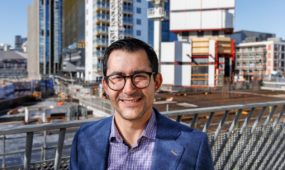Medical imaging method helps stroke tremor treatment
Health & Medical
THERE is a hint of a smile on David McGrail’s face when he picks up his guitar and starts playing a few notes.

Sign up to receive notifications about new stories in this category.
Thank you for subscribing to story notifications.
Just eight months ago the 23 year old was battling a constant and vigorous tremor in his right arm which meant playing his Ashton guitar was near impossible.
As well as this, he couldn’t easily feed himself or hold a glass of water. He’d been forced to give away his two passions – rowing and playing guitar – and his tremor was so intrusive he had to sit on his hand to stop shaking.
He was constantly tired as the tremor stopped him getting to and staying asleep at night, and he was underweight due to feeding difficulties and the involuntary exercise the constant tremor caused. He hated the stares he attracted when out in public.
But David’s life dramatically changed for the better when he was referred to
Flinders Medical Centre Neurologist Dr Rob Wilcox for treatment of his condition known as “stroke induced right upper limb rubral tremor” (severe continuous flapping tremor) and “task dependent dystonia” (involuntary muscle movements whenever David tried to perform skilful hand movements).
In November 2014, David became the youngest person in South Australia to receive Deep Brain Stimulation (DBS) – a surgical procedure which uses an implanted medical device to send electrical stimulation via leads inserted into the brain to the regions that control movement, blocking abnormal nerve signals.
In a world-first, Dr Wilcox and his colleagues, Head of Magnetic Resonance Imaging Dr Marc Agzarian, Chief Medical Imaging Physicist Dr Donald McRobbie and Neurosurgeon Dr Matt McDonald, used a newly-developed medical imaging method called “constrained spherical deconvolution fibre tractography” to accurately target living brain neuron fibres in David’s brain.
This procedure allowed Dr Wilcox to see living brain neuron fibres and follow these to functioning areas of the brain that could be targeted to suppress David’s tremor.
“Rubral tremors are awful and exhausting for the patient and don’t respond well to any medication,” Dr Wilcox says.
“DBS is usually performed on brains with no significant structural brain damage, but in contrast David’s stroke had damaged a significant part of his brain.
“The results were very encouraging as we were able to improve David’s tremor and dystonia by about 80 to 90 per cent within a few months of his DBS surgery.
“It’s really a very satisfying result for David. At every meeting since his DBS, David’s tremor and dystonia have improved and I think there is a chance that we can completely suppress these problems.
“But what is really wonderful is to see David gaining weight, fitness and confidence.”
David’s debilitating tremor started at age 17 as a result of brain damage from a significant stroke David suffered while undergoing treatment for leukaemia, which he was diagnosed with at 16.
His battle with cancer and ensuing stroke was tough enough, but he also spent time on life support and twice his family, including mum Patti, were told to say goodbye.
When he regained consciousness, it was discovered that a significant bleed on the left hand side of his brain had resulted in no feeling on the right side of his body, short term memory and vision loss, and for a while he couldn’t walk.
With all of David's efforts going into beating leukaemia, rehabilitation for his stroke took a back seat as he began to notice the tremor slowly emerging, as well as seizures. But when he was placed in remission in 2008, his focus shifted to getting his tremor under control.
“After going into remission it was hard for David to get his life back in order and go
“He’s right handed and couldn’t write anymore, or play guitar which he loved. He’d also been rowing for club and school and was doing really well and had won a few competitions and awards, so not being able to do that really knocked him around.
“His vision was limited but it was the tremors that really impacted on his life.”
For David, it’s the simple things that he’s now enjoying the most.
First published in Southern Health News
Jump to next article



